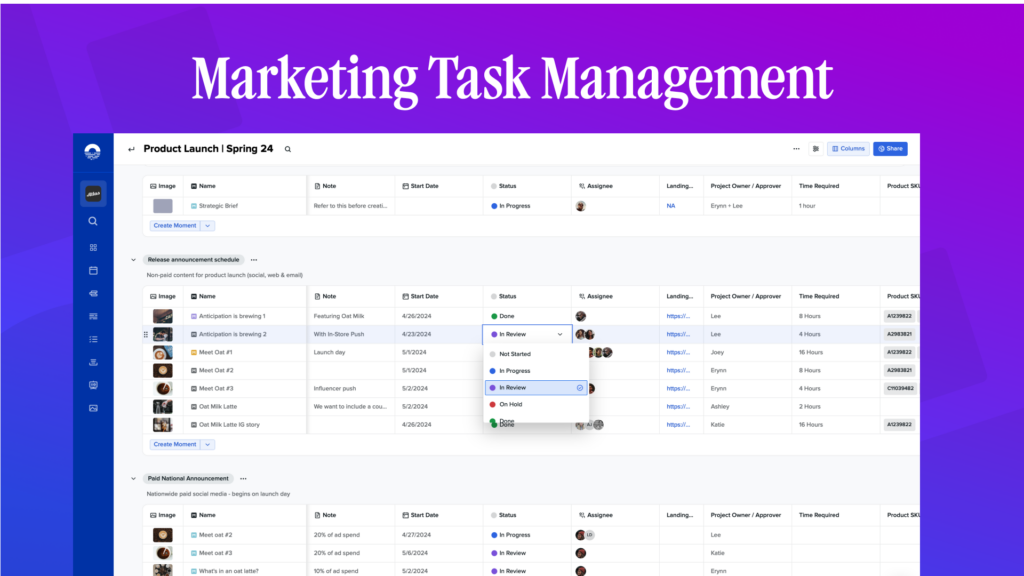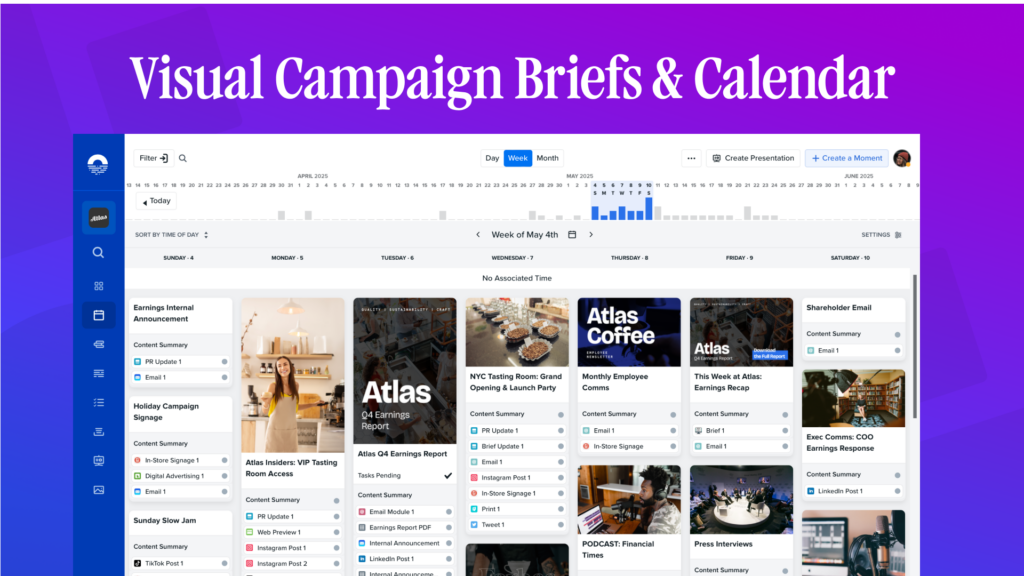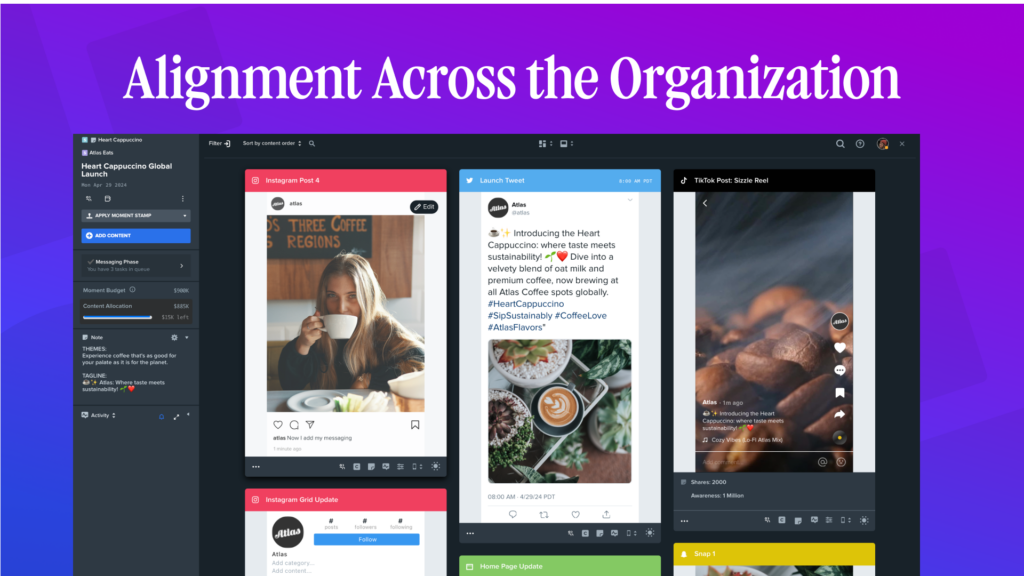by Lee Dussinger
Leading a marketing team requires the balance of being able to manage the workflows of an often very busy team – while also being able to critique marketing work. These are two very different functions that are both equally necessary to succeed as a marketing manager. Managers need marketing team management software that provides features to facilitate both of these crucial functions.
If you want to know how Opal makes an impact for the marketing managers who oversee people and production – that’s what we’re showcasing here…
Firstly, we’re going to dig into the capabilities of our team management software that empower leaders to coordinate the who, the what, and the when. Next, we’ll be digging into the visual calendar and briefing that make the marketing work come to life. Lastly, we’ll be putting a spotlight on how Opal solves big-picture marketing alignment across the entire organization.
Marketing Task Management

At almost any org (regardless of size), managing the marketing functions requires handling timelines, employee capacity, priorities, and countless other variables you’d expect with any other team.
However, since success around marketing tasks is more focused on having an impact rather than checking a box, managers need to be flexible. The complex nature of marketing work means that timelines can change in a moment and team availability can change along with it.
In addition, marketing teams are often inundated with requests to serve the rest of the organization.
That’s why managers need a marketing task management software that is flexible, provides visibility, and is tailored for marketing. Here’s what Opal offers:
Crystal-Clear Statuses
Marketing team management software needs a central view to display the status of – and manage – what’s going on. When your team has a series of important projects that you’re activating against, people throughout the org will be paying attention. Being able to instantly display the status/phase of each project, who’s working on it, when it’ll be ready, and more is crucial.
The custom columns in Opal’s free-form Boards space are purpose-built for this. This space empowers you to always have an up-to-date status of each project – as well as ensure everyone has that visibility, too.
Workflows
Sometimes managing the individual steps of a project is simple enough that it can be handled in the columns of Opal Boards. However, for more complicated projects with numerous task and approval phases, our workflows are a critical component of coordinating each step of more complex marketing projects. This is truly a cardinal feature of marketing task management software.
Opal workflows empower managers to plot out and assign a set of tasks to the relevant team members. Not only does this crystalize the specifics of who does what, but the workflow automatically taps the right individual automatically when it’s time for them to work on the project.
Intaking Marketing Requests
Like we mentioned above, many marketing organizations provide services to the rest of the organization. Ensuring that those requests are doable and don’t overrun the marketing org’s internal priorities requires skillful management. That’s why a critical function that a marketing task management software needs to offer is a space for marketing requests to come through.
This space needs to be accessible to the entire org to field requests, yet be routed through the management layer who can triage requests and activate the team.
In Opal, we solved marketing requests by integrating with Formstack. This enables Opal users to fill out custom web forms with their requests – and have those requests populate an intake space in Opal. This solution ensures that managers can formalize the processes around requests, just like any other step of the process.
Reviews & Approvals
Marketing managers aren’t simply project managers who coordinate the marketing team like a resource. They are much more than that. To empower their teams to drive impact, managers must have a POV on every discipline within the team. They need to be able to provide specific technical feedback as well as strategic guidance for how a specific tactical piece connects to the big-picture strategy.
In the rare cases where managers don’t have the ability to give feedback, connecting their team members with reviewers is critical.
Either way, effective software will have features built to make reviews and approvals effective and convenient. While giving approval is a fairly standard “yes” or “no”, offering qualitative feedback requires a platform.
In Opal, reviews of marketing content take place in-context of the content itself. This means that managers can leave comments and feedback directly on assets. In addition to having the content at hand, managers can also easily double-check the original assignment to ensure the finished project matches the initial request.
Visual Campaign Briefs & Calendar

SInce coordinating the work is just half of the job, a marketing task management tool is just one half of what managers need. Managers also need to be able to interact with, and often plan, marketing content. The cornerstone visual features of Opal make all of these functions more intuitive – and geared towards doing work that drives impact.
Visual Calendar
In many organizations, managers are responsible for setting and maintaining the brand’s publishing cadence. What channels are used, on what days, and at what times often falls to the purview of one or more team/channel managers.
The Opal central calendar is the ideal space to plan, understand, and even update go-to-market scheduling. The visual marketing calendar shows what content is being published as well as a thumbnail of what it will look like. For the organizations that run their marketing on Opal, one look at the Opal calendar gives a snapshot of exactly how the brand goes to market.
If changes are needed, you can make them right on the calendar. You can address content gaps or collisions directly and can also compare how the brand is going to market across multiple accounts or channels. By having a central and visual space to plan your go-to-market messaging, everyone creates better experiences for customers in market.
Marketing Briefs
Making assignments and setting the agenda is a critical component of how a lead activates their team. Just like every other feature in Opal, briefing is visual. Using the free-form planning space Boards, managers can set up living, visual briefs that provide the perfect context for the team. Not only will it be more likely that the team reads and digests the brief – but they can also influence it, too.
Learn how to write a marketing brief.
Even better, these briefs in Boards live in the same space where team members will be creating their content. This means if they ever need to double-check the assignment, the original brief is right at hand.
True-to-Life Content Previews
Like we mentioned in the above section on marketing work management software, reviewing content is a key task for marketing managers. In Opal, reviewing a large volume of content has never been more beneficial. By being able to do reviews on the true-to-life content (and in context of the brief), you’ll give more insightful feedback that improves the content.
Reviewing disconnected images and lines of copy in a Google Doc just can’t compare to the experience of evaluating content exactly as your audience will see it.
All in One Platform
By combining the real work for the team with marketing task management, there’s another key advantage. Team leads and managers have the ability to manage the workflow in the same space where the work is done.
Not only is the context of the real work always available when making decisions, but having one platform simply makes you manage everything more efficiently.
Alignment Across the Organization

While Opal delivers specific value as a marketing team management software to managers, it offers another crucial additional benefit that has an impact on EVERY organizational layer. That advantage is organization-wide alignment.
Marketing managers are the middle layer of the organization. That means they directly engage with both the independent contributor layer as well as the executive level. When an organization is misaligned, executives don’t understand how their strategic ideas are reflected in the everyday tactics. Simultaneously, team members don’t understand their priorities or the big-picture context behind their assignments. Managers are caught in the middle, having to dedicate their time to communicating up and down the organization.
The final benefit of the Opal platform is solving the alignment gap. Opal does this by visually showing the connection between strategic executive initiatives and what team members create.
Custom Demo of Marketing Team Management Software
When you coordinate in Opal, you’ll manage your team and the work in the same platform.
That’s why brands like Target, Starbucks, GM, and countless others trust Opal.
The best way to understand how a marketing team management software can change how you work is to see it in action.
We recommend scheduling a custom demo with a product expert. They’ll walk you through the key features that will make a difference to how you work everyday.


